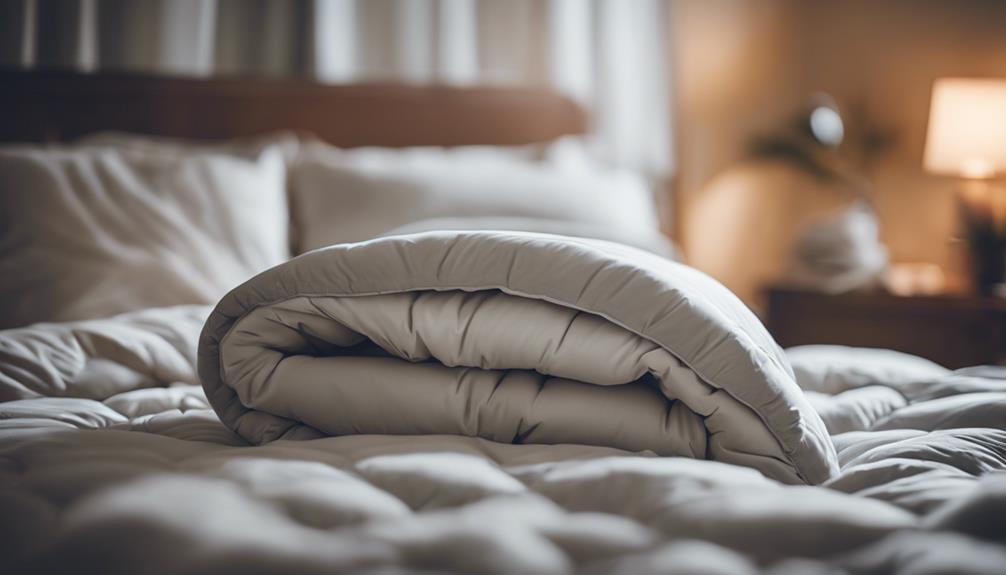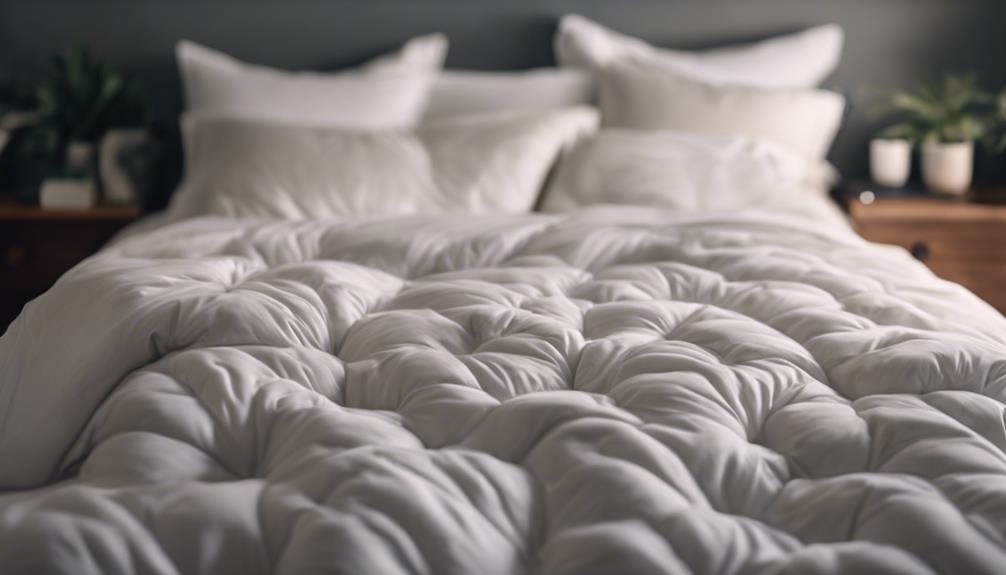We need to replace down comforters every 10-15 years. Indicators include flattened areas, lack of fluffiness, or shifting fill. Regular cleaning and maintenance can prolong the lifespan. Using a duvet cover and avoiding directly laying on it are helpful. Other signs to look out for are wear and tear, clumps of feathers, or fabric integrity issues. Proper maintenance is essential for longevity. If your comforter lacks loft and warmth, it may be time for a replacement. Checking for signs of wear, investing in a new comforter, and following care instructions are crucial. Ensuring comfort and warmth are key.
Key Takeaways
- Quality down comforters last 10-15 years on average.
- Check for flattened areas or loss of warmth.
- Regularly inspect for wear and tear.
- Invest in a new down comforter for ongoing comfort.
- Follow care recommendations to prolong lifespan.
Signs Your Down Comforter Needs Replacement
If your down comforter lacks fluffiness when fluffed, it may be time for a replacement. Over time, down comforters can start to show signs of wear and tear. One common indicator is feeling for uneven distribution of down, which can result in certain areas feeling flat or lacking warmth.
Inspecting the comforter for wear and tear, especially over the shoulders where compartments may be worn out, is important in determining if it's time to replace it. Additionally, if you notice bunching or shifting of the fill inside the comforter, this could indicate that the comforter needs to be replaced.
Another aspect to take into account is the outer shell of the comforter. Any holes, tears, stains, or discoloration on the shell are clear signs that it might be time to invest in a new down comforter. Keeping an eye out for these key indicators will make sure that you're getting the most out of your bedding.
Maximizing the Lifespan of Your Comforter

To guarantee the longevity of your down comforter, proper care and maintenance are essential. Down comforters typically last 10-15 years with regular cleaning and upkeep.
One way to maximize the lifespan of your comforter is by using a duvet cover. Duvet covers act as a protective barrier, shielding your comforter from dirt and stains. Additionally, inspect the shoulder area regularly for worn-out compartments, as this can indicate the need for a replacement.
Cleaning your down comforter at least once a year can also help prolong its lifespan. Proper care is vital; avoid laying on top of the comforter to prevent unnecessary wear and tear.
Time to Replace Your Down Comforter?
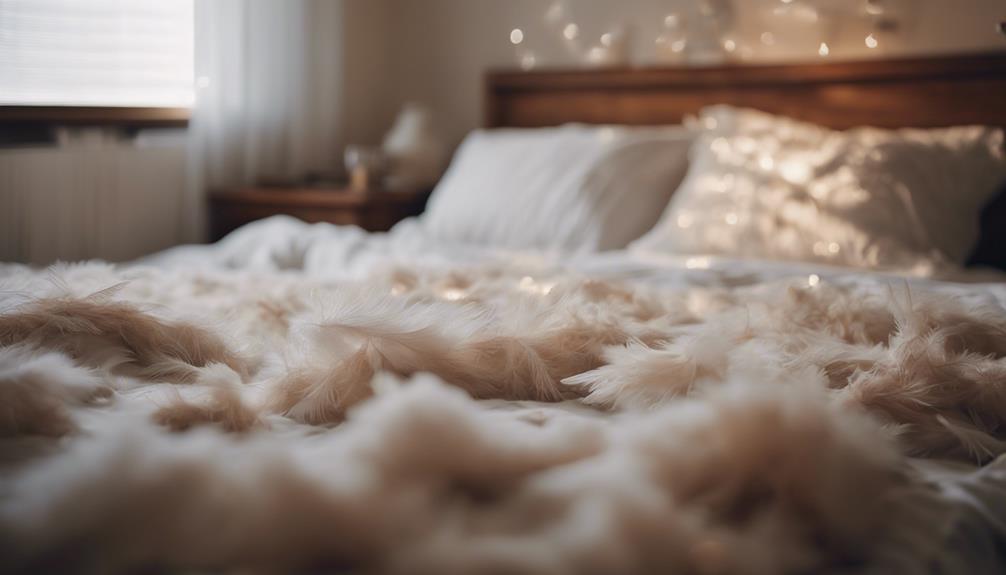
When determining whether it's time to replace your down comforter, assess its condition for signs of wear and tear, lack of fluffiness, or shifting fill. A down comforter should last around 10-15 years for best comfort and hygiene.
If your comforter is worn, with flattened areas, visible tears, or clumps of feathers gathering in one spot, it might be time for a new one. Over time, the fill in a down comforter can shift, leading to uneven distribution and decreased warmth. Lack of fluffiness is another clear indicator that your comforter has seen better days.
Regular maintenance and proper care can extend the lifespan of your comforter, but when it starts to lose its plushness and warmth, replacing it is essential for maintaining freshness, cleanliness, and ensuring a good night's sleep. Remember, timely replacement of down comforters is important for healthier sleeping conditions and improved comfort.
Testing the Need for Replacement
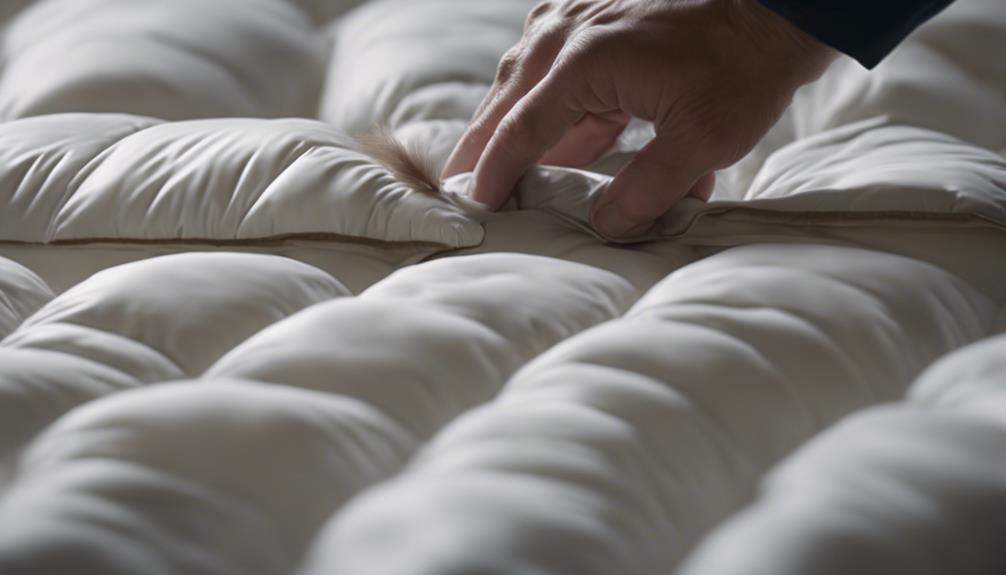
When evaluating the need to replace a down comforter, it's important to assess:
- Fill flattening
- Check fabric integrity
- Monitor allergen buildup
These key points can help determine if the comforter is still providing ideal warmth and comfort. Regularly inspecting these factors guarantees that your down comforter continues to serve its purpose effectively.
Assessing Fill Flattening
As we fluff the down comforter and hold it up to the light to check for lack of down in the shoulder area, we can evaluate the need for replacement based on fill flattening.
Flattening of the fill within the comforter can occur over time due to tossing and turning, causing friction that breaks down the down clusters. If there are thinning areas, flat spots, or an overall lack of fluffiness, it may be time to contemplate replacing the comforter. These signs indicate that the down has degraded and lost its insulating properties.
Typically, down comforters last between 8 to 15 years before needing replacement, so gauging fill flattening is essential in determining when it's time for a new one.
Checking Fabric Integrity
After evaluating fill flattening in the down comforter, the next step is to check the fabric integrity to determine if replacement is necessary. When examining the fabric of the comforter, pay attention to the following:
- Hold the comforter up to a light source to identify any lack of down in the shoulder area.
- Inspect for signs of wear and tear, especially over the shoulders where pressure is exerted.
- Look for thinning fabric or uneven distribution of down clusters.
- Feel for thin spots, holes, or clumped down areas.
- Assess the overall condition to decide if it's time for a new comforter for better comfort and insulation.
Monitoring Allergen Buildup
To determine if replacement is necessary, evaluate allergen buildup in the down comforter by examining for dust mites, pet dander, or pollen. Regular cleaning may help reduce allergen levels, but severe cases might require replacement. If allergy symptoms persist despite cleaning efforts, it could indicate a significant allergen buildup. Monitoring allergens is essential for maintaining a healthy sleep environment. Consider the following table for guidance on evaluating allergen buildup:
| Allergen Type | Signs of Buildup | Action Needed |
|---|---|---|
| Dust Mites | Visible debris on comforter | Consider replacement |
| Pet Dander | Unpleasant odor or stains | Evaluate cleaning effectiveness |
| Pollen | Allergy symptoms worsen | Monitor closely and consider replacement |
Factors Influencing Replacement Timing
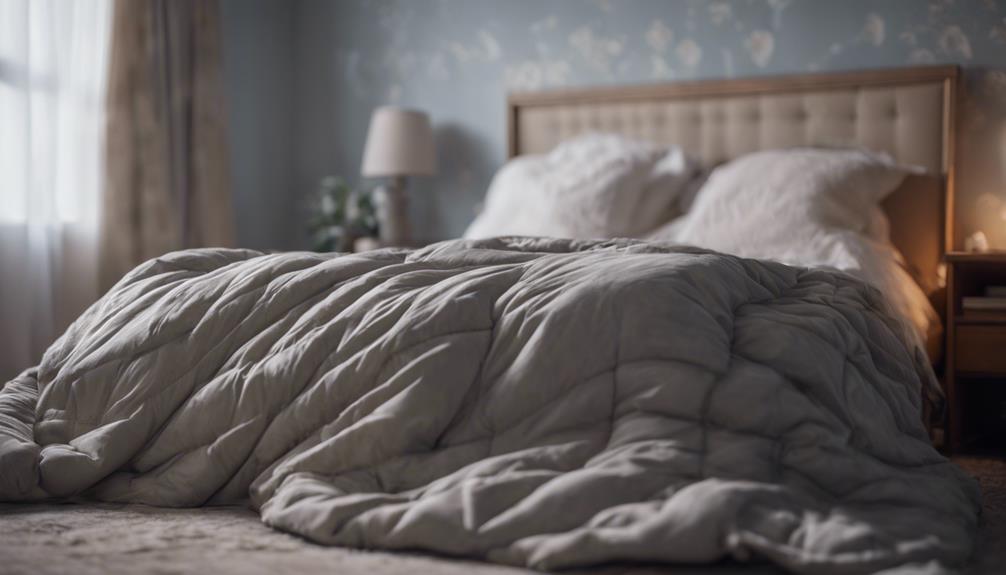
When considering the timing for replacing down comforters, it's crucial to pay attention to factors like:
- Material wear and tear
- Allergen buildup concerns
- The loss of fluffiness
These elements can greatly impact the comfort and effectiveness of the comforter over time. By keeping an eye on these key factors, we can guarantee a cozy and clean sleeping environment for a more restful night's sleep.
Material Wear and Tear
Inspecting down comforters regularly for visible signs of wear and tear on the material is essential in determining when replacement is necessary. Factors influencing the timing of replacement include time, material wear and tear, and signs such as thinning fabric, holes, fraying seams, stains, discoloration, and loss of fluffiness. To decide if a down comforter needs replacing, check for these indicators regularly.
Thin or worn areas, holes in the fabric, frayed seams, stains, and discoloration are all signs that the comforter may not be in good condition. Loss of fluffiness, which affects the comforter's ability to insulate, is also a key indicator that it may be time for a replacement.
Allergen Buildup Concerns
Regularly checking down comforters for signs of wear and tear is essential in determining replacement timing; when it comes to allergen buildup concerns, the impact on individuals with allergies can't be underestimated. Dust mites and pet dander can accumulate in duvets over time, worsening symptoms for allergy sufferers.
Allergen buildup may lead to respiratory issues and poor sleep quality, highlighting the importance of addressing this issue promptly. Washing down comforters regularly can help reduce allergens, but for individuals sensitive to allergens, more frequent replacement might be necessary.
Using a washing machine to clean the duvet can be an effective way to minimize allergen buildup, ensuring a healthier sleeping environment for allergy-prone individuals.
Loss of Fluffiness
Maintaining the fluffiness of a down comforter is essential to prolonging its lifespan and ensuring maximum comfort. When considering the replacement of down comforters due to loss of fluffiness, several factors come into play:
- Loss of fluffiness in down comforters can indicate the need for replacement.
- Factors like compression from body weight and moisture absorption can lead to decreased fluffiness.
- Over time, down clusters can break down, reducing the comforter's loft and insulation.
- Insufficient loft and warmth may prompt the replacement of a down comforter.
- Regularly fluffing and shaking the comforter can help maintain its fluffiness but may not always restore its original loft.
Choosing the Right Replacement Comforter
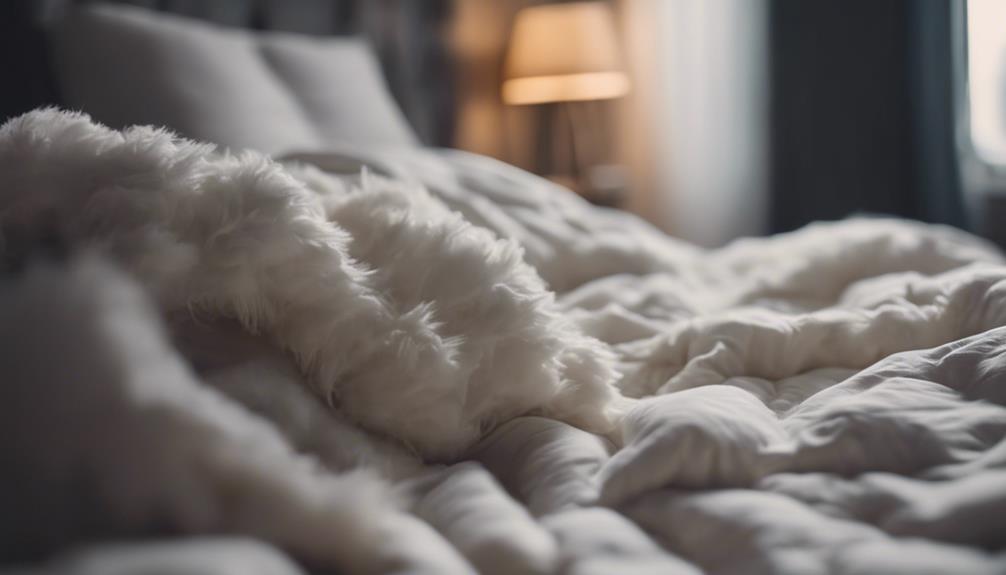
When searching for a replacement down comforter, consider factors such as warmth level, fill material, and construction style to guarantee utmost comfort and longevity.
A down comforter with a baffle box construction ensures even distribution of fill, preventing clumping and maximizing loft for a cozy sleep experience. Consider a thread count under 800 for increased durability.
Selecting the proper size based on your bed dimensions is essential to ensure adequate coverage and comfort.
Remember that regular maintenance, including properly cleaning and dry cleaning, is crucial for prolonging the lifespan of your replacement down comforter.
Caring Tips for Your Comforter
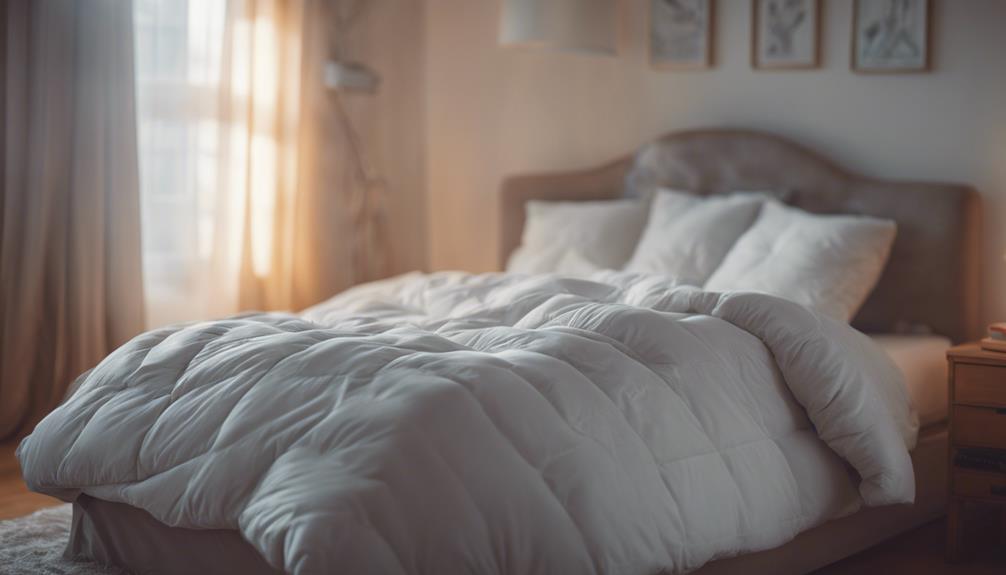
When choosing a replacement down comforter, it's crucial to take into account caring tips that can help preserve its quality and longevity. Regularly fluffing and shaking the comforter to redistribute the filling maintains its loft and ensures even warmth distribution.
Using a duvet cover is essential to protect the comforter from dirt, stains, and wear, extending its lifespan. Following the manufacturer's care instructions, such as dry cleaning or laundering, keeps your comforter in top condition.
Avoid laying or sitting directly on the comforter to prevent compression, which can impact its insulation properties and longevity. Consider utilizing a comforter storage bag when not in use to shield it from dust and pests, ensuring it remains fresh longer.
Duration of Down Comforter Longevity
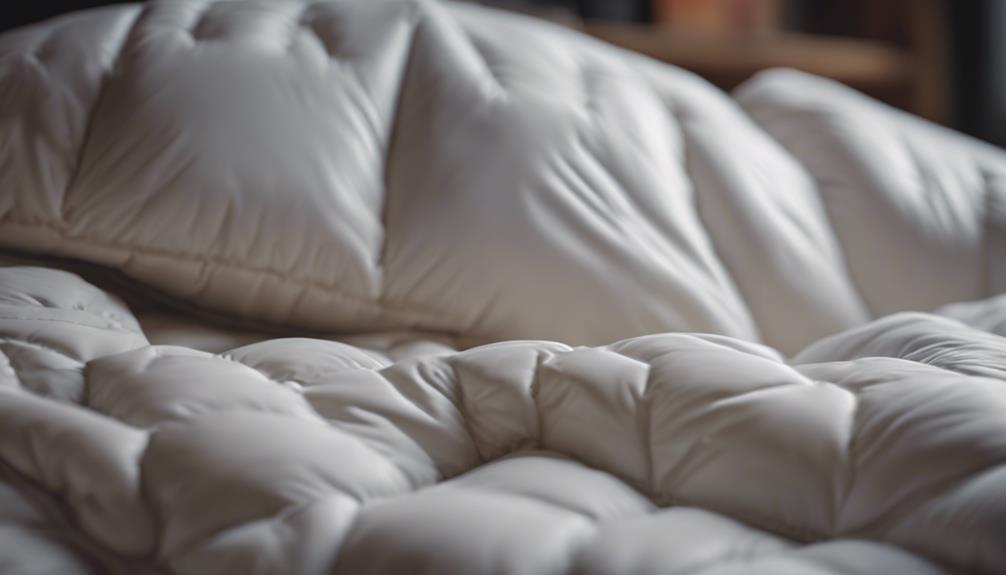
Quality down comforters typically last 10-15 years before requiring replacement. Factors such as the comforter's quality, how restless the sleeper is, and external pressure can affect how long it lasts. To tell if yours needs replacing, regularly check the shoulder area for worn-out compartments.
Vero Linens offers high-quality down comforters designed for lasting comfort and durability. Following Vero Linens' care recommendations can help prolong your comforter's lifespan. Remember, even the best down comforters have a limit to their longevity. If you notice significant wear and tear, such as flattened areas or a decrease in warmth, it may be time for a replacement.
Investing in a new down comforter after its long time of service ensures you continue to enjoy the luxurious comfort and warmth they provide.
Frequently Asked Questions
What Is the Life Expectancy of a Down Comforter?
The life expectancy of a down comforter typically ranges from 10 to 15 years. Factors like quality, sleeper's restlessness, and external pressure influence how long it lasts.
Inspect the shoulder area for signs of wear to determine if it needs replacing.
Vero Linens offers durable down comforters with different warmth levels and baffle box construction.
Regular cleaning and maintenance can help extend the life of a down comforter.
How Do You Know When to Replace a Down Comforter?
When it's time to replace a down comforter, keep an eye out for worn-out compartments in the shoulder area and check the fill for signs of wear by fluffing and shaking it.
Look for bunching, shifting, holes, tears, stains, or discoloration in the shell.
Regular maintenance helps, but replacing your comforter every 10-15 years is key for quality sleep and hygiene.
How Often Should You Launder a Down Comforter?
We recommend laundering a down comforter at least once a year to maintain its fluffiness and insulation. Regular cleaning can extend the lifespan of the comforter. Consider using a laundromat for large comforters for best results.
Following manufacturer recommendations for cleaning guarantees longevity and quality. Our advice is to clean your down comforter annually to keep it cozy and in top condition.
How Often Should I Replace a Down Duvet?
When it comes to replacing down comforters, it's important to keep comfort and hygiene in mind. Regular replacement every 10-15 years is essential to ensuring a fresh and clean sleeping environment.
Is Fluffing a Down Comforter a Sign That It Needs to Be Replaced?
Fluffing a down comforter is a maintenance task that should be done regularly to keep it in good condition. The down comforter fluffing time frame varies, but if fluffing no longer restores loft and fluffiness, it may be a sign that the comforter needs to be replaced.
Conclusion
To wrap up, when it comes to replacing your down comforter, it's better to be safe than sorry. You don't want to be stuck with a flat, lumpy mess when you could be snuggled up in a fluffy cloud of warmth.
So, keep an eye out for the signs, take good care of your comforter, and don't hesitate to make the switch when the time comes. Your cozy nights of sleep are worth it!
